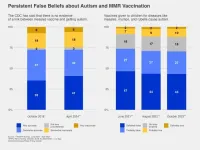(Press-News.org) Coworker and employer support are strong predictors of nurses planning to stay in their jobs, while symptoms of depression are linked to nurses planning to leave, according to a study conducted at the height of the COVID-19 pandemic by researchers at NYU Rory Meyers College of Nursing.
The research—published in the Online Journal of Issues in Nursing, a journal of the American Nurses Association—examines both pandemic-related factors and the overall work environment for nurses and can help organizational leaders improve their support for and retention of their nursing workforce.
“Coming out of the pandemic, the mental health of healthcare workers has been top of mind,” said Amy Witkoski Stimpfel, assistant professor at NYU Rory Meyers College of Nursing and the study’s senior author. “Our findings suggest that focusing on organizational support and mental health can improve nurses’ wellbeing and increase the chances that they will stay in their jobs.”
The intense working conditions during the COVID-19 pandemic exacerbated stress and burnout among nurses. Many left their jobs, stretching a workforce struggling with shortages even thinner. Inadequate nurse staffing and turnover are linked with a range of negative outcomes, including worse quality of care for patients, poor health for fellow nurses, and increased costs for health systems.
Witkoski Stimpfel and her co-author, NYU Meyers doctoral student Kathryn Leep-Lazar, wanted to understand what characteristics of a nurse’s job, work environment, and mental health predict whether they intend to stay in their role. The researchers surveyed 629 U.S. nurses across 36 states during the summer of 2020—when many parts of the country were experiencing surges of COVID-19 cases and hospitalizations.
Witkoski Stimpfel and Leep-Lazar gathered information about the nurses’ workplaces, including the type of setting, schedule, patients per nurse, and length of shift, as well as COVID-specific factors, such as whether nurses were caring for COVID patients and had adequate personal protective equipment (PPE). They also collected demographic information and measures of anxiety, sleep issues, and depression, comparing all of these factors with nurses’ intent to stay in their jobs one year from now.
The researchers found that the strongest factor predicting whether nurses intended to remain in their roles was having support systems at work. Nurses who felt supported by their colleagues were nearly twice as likely to want to stay in their jobs compared with those who didn’t feel as supported, while nurses who felt supported by their organization were 2.4 times more likely to say they would stay. Workplace support was an even stronger predictor of nurses’ intentions to stay in their jobs than COVID-specific factors, including pandemic preparedness, PPE shortages, and whether nurses were directly caring for COVID-19 patients.
In contrast, symptoms of depression were associated with nurses planning to leave their jobs within the year. Nurses with mild symptoms of depression were 50% less likely to say they plan to stay in their jobs compared to those with minimal symptoms, while nurses with moderate or severe symptoms of depression were 73% less likely.
“We know that there is significant overlap between depression and occupational burnout, with both capturing feelings of fatigue and a lack of energy. It’s possible that many of the nurses reporting depressive symptoms were in fact experiencing exhaustion and burnout from elevated workloads and long hours during the pandemic,” added Witkoski Stimpfel.
“Considering that 60% of the nurses we surveyed reported some level of depression, organizational leaders need to be paying attention to the mental health of this critical workforce,” said Leep-Lazar, the study’s first author.
The researchers encourage employers to examine their mental health resources—such as employee assistance programs and therapy covered by employer-sponsored benefits—available to nurses. In addition to providing support for individual nurses, the researchers urge organizations to create healthy work environments that foster support among staff and have policies and practices that protect nurses against depression, burnout, and other poor mental health outcomes.
“The good news is that the factors we identified—workplace support and mental health—can be addressed through targeted efforts, some of which may already be in place,” said Witkoski Stimpfel.
The study, “Factors Associated with Working During the COVID-19 Pandemic and Intent to Stay at Current Nursing Position,” is available to members of the American Nurses Association starting on May 31, 2024 and will be publicly available on September 30, 2024. DOI: 10.3912/OJIN.Vol29No02Man03
END
Mental health, lack of workplace support are leading factors driving nurses from jobs
Study conducted at the height of the pandemic reveals how workplaces shape nurses’ experiences and intentions to stay or leave their jobs
2024-06-03
ELSE PRESS RELEASES FROM THIS DATE:
U.S. health departments experience workforce shortages and struggle to reach adequate staffing levels in public health
2024-06-03
Gaps persist in hiring enough U.S. public health workers and health departments continue to face challenges in recruiting new employees, according to a new study by Columbia University Mailman School of Public Health and Indiana University. Insufficient funding, a shortage of people with public health training, and a lack of visibility for public careers, in addition to lengthy hiring processes, are cited as barriers contributing to an absence of progress for achieving a satisfactory level of workers. The results ...
Redox Science Meets Medicine at the 26th International Conference on Redox Medicine 2024 this June in Paris
2024-06-03
Redox Science Meets Medicine at the 26th International Conference on Redox Medicine 2024 this June in Paris
The 26th International Conference on Redox Medicine 2024 will take place this month, on June 27-28 at Fondation Biermans-Lapôtre in Paris, France.
With 41+ communications and participants from 20 different countries, the conference promises a diverse exchange of knowledge and ideas.
The sessions of the conference are organized around key topics, with each speaker addressing a specific ...
Albert Einstein College of Medicine names Marla Keller, MD, Executive Dean
2024-06-03
June 3, 2024—(BRONX, NY)—Marla Keller, M.D., a national leader in academic medicine and in clinical and translational research and training, has been appointed executive dean at Albert Einstein College of Medicine. In this role, Dr. Keller will work closely with Yaron Tomer, M.D., the Marilyn and Stanley M. Katz Dean at Einstein, other executive leaders at the College of Medicine and Montefiore, and the Board of Trustees to achieve the vision for the institution. As Einstein’s second most senior officer, she will drive strategic planning for the College of Medicine and provide guidance across all academic and research programs.
Dr. ...
Two-pronged attack strategy boosts immunotherapy in preclinical studies
2024-06-03
JUNE 3, 2024, NEW YORK – A novel immunotherapy approach developed by Ludwig Cancer Research scientists employs a two-pronged attack against solid tumors to boost the immune system’s ability to target and eliminate cancer cells.
The research focuses on an immunotherapy called adoptive cell transfer (ACT), which involves extracting T cells from a patient, enhancing their ability to fight cancer, expanding them in culture and reinfusing them into the patient’s body.
“While T cell therapies have shown tremendous ...
Microscopic defects in ice shape how massive glaciers flow, study shows
2024-06-03
As they seep and calve into the sea, melting glaciers and ice sheets are raising global water levels at unprecedented rates. To predict and prepare for future sea-level rise, scientists need a better understanding of how fast glaciers melt and what influences their flow.
Now, a study by MIT scientists offers a new picture of glacier flow, based on microscopic deformation in the ice. The results show that a glacier’s flow depends strongly on how microscopic defects move through the ice.
The researchers found they could estimate ...
False belief in MMR vaccine-autism link endures as measles threat persists
2024-06-03
As measles cases rise across the United States and vaccination rates for the MMR (measles, mumps, rubella) vaccine continue to fall, a new survey finds that a quarter of U.S. adults do not know that claims that the MMR vaccine causes autism are false.
The Centers for Disease Control and Prevention (CDC) has said there is no evidence linking the measles vaccine and getting autism. But 24% of U.S. adults do not accept that – they say that statement is somewhat or very inaccurate – and another 3% are not sure, according to the survey by the Annenberg Public Policy Center (APPC) of the University of Pennsylvania. About three-quarters of those surveyed ...
Type of weight loss surgery women undergo before pregnancy may influence children’s weight gain
2024-06-03
BOSTON—The type of weight loss surgery women undergo before becoming pregnant may affect how much weight their children gain in the first three years of life, suggests a study being presented Monday at ENDO 2024, the Endocrine Society’s annual meeting in Boston, Mass.
Researchers found children born to women who underwent the bariatric procedure known as sleeve gastrectomy before they became pregnant gain more weight per month on average in the first three years of life compared with children born to women who had the less common ...
Meditating with headband that tracks brain activity may improve surgical recovery in patients with Cushing’s
2024-06-03
BOSTON—Patients with Cushing’s syndrome who are recovering from surgery and wear a headband that tracks brain activity while they meditate may have less pain and better physical functioning compared with patients not using the device, suggests a study being presented Monday at ENDO 2024, the Endocrine Society’s annual meeting in Boston, Mass.
The headband, called MUSE-2, uses electroencephalogram (EEG) sensors to measure brain activity and provides audio biofeedback while a person meditates.
Cushing's syndrome is a rare ...
Low socioeconomic status raises pregnant women’s risk of exposure to thyroid-disrupting chemicals
2024-06-03
BOSTON—Exposure to some endocrine-disrupting chemicals (EDCs) that harm the thyroid gland has increased over the past 20 years among U.S. women of childbearing age and pregnant women, especially among those with lower social and economic status, a new study finds. The results will be presented Monday at ENDO 2024, the Endocrine Society’s annual meeting in Boston, Mass.
“Our research underscores the importance of addressing socioeconomic disparities in EDC exposure among women of reproductive age and pregnant women to mitigate potential adverse effects on thyroid health,” ...
Early menopause linked to greater risk for breast, and possibly ovarian cancer
2024-06-03
BOSTON—Some women who experience menopause early—before age 40—have an increased risk for developing breast and ovarian cancer, according to research being presented Monday at ENDO 2024, the Endocrine Society’s annual meeting in Boston, Mass.
“There is also higher risk of breast, prostate and colon cancer in relatives of these women,” said Corrine Welt, M.D., chief of the Division of Endocrinology, Metabolism and Diabetes at the University of Utah Health in Salt Lake City, Utah.
Welt and colleagues began the study with the hypothesis that some women with primary ovarian insufficiency and their family members might ...
LAST 30 PRESS RELEASES:
New expert guidance urges caution before surgery for patients with treatment-resistant constipation
Solar hydrogen can now be produced efficiently without the scarce metal platinum
Sleeping in on weekends may help boost teens’ mental health
Study: Teens use cellphones for an hour a day at school
After more than two years of war, Palestinian children are hungry, denied education and “like the living dead”
The untold story of life with Prader-Willi syndrome - according to the siblings who live it
How the parasite that ‘gave up sex’ found more hosts – and why its victory won’t last
When is it time to jump? The boiling frog problem of AI use in physics education
Twitter data reveals partisan divide in understanding why pollen season's getting worse
AI is quick but risky for updating old software
Revolutionizing biosecurity: new multi-omics framework to transform invasive species management
From ancient herb to modern medicine: new review unveils the multi-targeted healing potential of Borago officinalis
Building a global scientific community: Biological Diversity Journal announces dual recruitment of Editorial Board and Youth Editorial Board members
Microbes that break down antibiotics help protect ecosystems under drug pollution
Smart biochar that remembers pollutants offers a new way to clean water and recycle biomass
Rice genes matter more than domestication in shaping plant microbiomes
Ticking time bomb: Some farmers report as many as 70 tick encounters over a 6-month period
Turning garden and crop waste into plastics
Scientists discover ‘platypus galaxies’ in the early universe
Seeing thyroid cancer in a new light: when AI meets label-free imaging in the operating room
Neutrophil-to-lymphocyte ratio may aid risk stratification in depressive disorder
2026 Seismological Society of America Annual Meeting
AI-powered ECG analysis offers promising path for early detection of chronic obstructive pulmonary disease, says Mount Sinai researchers
GIMM uncovers flaws in lab-grown heart cells and paves the way for improved treatments
Cracking the evolutionary code of sleep
Medications could help the aging brain cope with surgery, memory impairment
Back pain linked to worse sleep years later in men over 65, according to study
CDC urges ‘shared decision-making’ on some childhood vaccines; many unclear about what that means
New research finds that an ‘equal treatment’ approach to economic opportunity advertising can backfire
Researchers create shape-shifting, self-navigating microparticles
[Press-News.org] Mental health, lack of workplace support are leading factors driving nurses from jobsStudy conducted at the height of the pandemic reveals how workplaces shape nurses’ experiences and intentions to stay or leave their jobs




